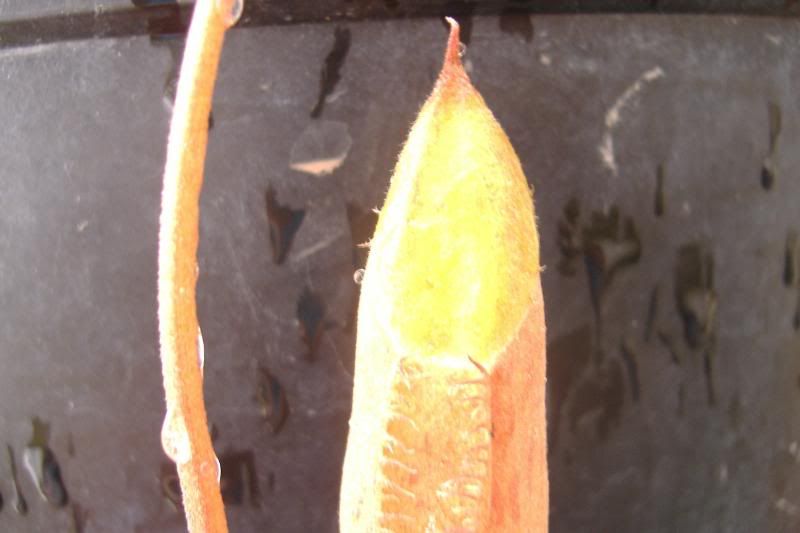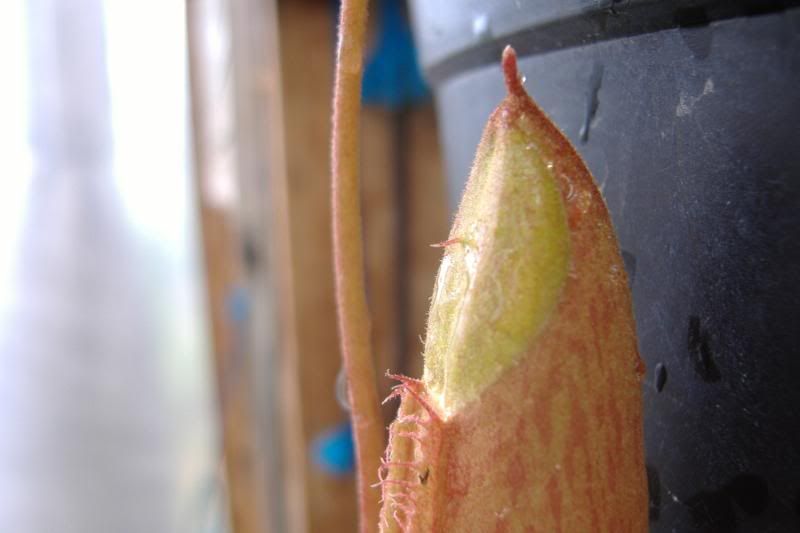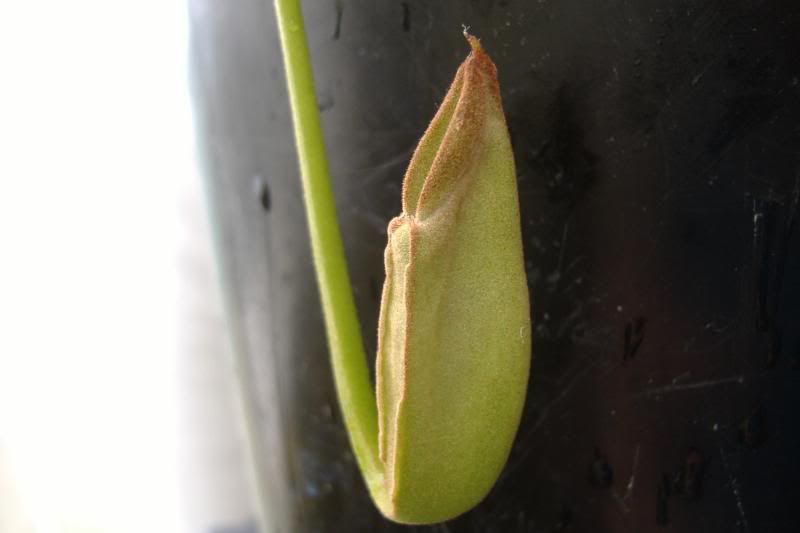|
|
Post by Marcello Catalano on Sept 18, 2008 6:12:12 GMT -10
Hi Tom, if those are all from the same bunch of seeds, they are all N. smilesii. N. anamensis is a synonim of N. smilesii. The spotted pitcher is somehow a bit different in colour and lid shape, but if it's from the same group of seeds, it must be a form of smilesii. But if you found that only plant with spotted pitchers and rounder lid in a completely different area, then we can talk about that! I'm not sure if geoffrayi is a synonim of kampotiana or smilesii, but that can be checked easily. A part from the photos, hard to examine, if someone can check those dry specimens and see if they are hairy, then we'll have an answer. Smilesii is hairy, kampotiana is glabrous. I doubt that in the kampot province we can have more than smilesii, bokor and kampotiana, but my doubt is not very scientific  . I would say geoffrayi must be one of these three anyway. Bokor is unlikely because it can be easily recognized. Personally I exclude at 100 percent that any of these narrow-leaved species can grow together with another narrow-leaved species, if not at a few kilometres distance (at that never even happened as far as I know). Tom, if I well remember you found those plants in Loei, the province where phu kradung is, but you said they were not on phu kradung or around it. I would be curious to know where you found them; even if a good number of smilesii locations are known at this time, one more is always welcome  Marcello |
|
|
|
Post by Marcello Catalano on Sept 18, 2008 6:34:23 GMT -10
I just checked the dry specimens photos. I would say geoffrayi is a synonim of kampotiana, for a series of (NOT DEFINITIVE) good reasons: -the lids are round. -it was found in kampot the same year as kampotiana, probably it was just a different form, these mistakes were commmon at the time. -smilesii and bokor are found on the mountains, I don't think that they would write the name of the whole province instead of the name of the mountain. -the smilesii from kampot (kirirom) can be easily recognized as smilesii, hairy and with oval lid. -these pitchers are small and roundish like those of kampotiana. -cheek wrote "kampotiana?" and not "smilesii?". So, these (not scientific) good reasons exclude smilesii, but they don't exclude a new species. I personally WOULD exclude a new species though, because in the same area and with the same characteristics, I don't think you can find two different species. Even the differences brought by the author are nowadays considered nothing. The only doubt comes when it says that the leaves are only sparsely hairy when young (while smilesii/anamensis is always completely hairy), and kampotiana is glabrous. But that little hair "when young" could be the hair on the tip of the leaf and on the tendril, which is peculiar of kampotiana. I'd like to see those specimens "live"  By the way, François,considering that kampotiana grows all along the coast, and Kampot city is on the coast, I really now think that when they wrote Kampot they meant the city. Is there any specimen of N. bokor or smilesii that on its label has just "Kampot" without any other indication? Are those labels with the only name "Kampot" all from the same author? Marcello |
|
Dave Evans
Nobiles
   dpevans_at_rci.rutgers.edu
dpevans_at_rci.rutgers.edu
Posts: 490
|
Post by Dave Evans on Sept 18, 2008 15:05:30 GMT -10
Hello Marcello,
There is at least one more glabrous species, N. red tiger. It is fairly different from the plant of mine you believe to be N. kampotiana... So just finding no hairs is not good enough for identification. From reading about N. kampotiana it would seem that it could be either species... It looks like, from looking at your photos, that my red tigers are closer to your plants of N. kampotiana, than is the "thorelii" I received from Jeff Shafer...
BTW, while the type of N. smilesii clearly doesn't show a mirabilis plant, the flowers of these Indochinese endemics are very similar with a very tall inflorescences.
But anyway, you have visited the area near Baw Saw and it is the same species as from Phu Kradung... But you said , "different" too. How are they different?
|
|
|
|
Post by Marcello Catalano on Sept 19, 2008 4:45:52 GMT -10
Hi Dave, there is more than one glabrous species in southern Thailand, we're going to describe them, one day or the other  Here is a good example of how dangerous are these nicknames. As you know, thai people have no idea about nepenthes classification. While at first it seemed that a new species from the south was being called tiger, I've witnessed myself how day after day - looking at the various web forums - the thai community started to call tiger more or less every narrow-leaved species. A couple of months ago I saw N. kampotiana from Trat called tiger. But I've seen smilesii, kongkandana and some other new species also being called tiger. So when we say tiger we say nothing. Now, let's talk of what we have  The indumentum is a quite stable feature, so far I didn't see any indochinese species that was an exception to this; even if François said that N. bokor can be variable, I want to wait and see my N. bokor in cultivation before giving any opinion about that. So, I often use indumentum to EXCLUDE one species or the other, but I also always add that a new species could always be included among the possibilities, because we never know... So, if someone says that a glabrous plant was found near Kampot, I exclude smilesii and then I give two possibilities: one is a new species, the other is kampotiana (because that's the only glabrous species known from the area). Of course I'm far from saying that any glabrous indochinese species is kampotiana!! Your "shafer thorelii", mate, is for sure the typical kampotiana as seen in the habitat! But let's take your tiger as another example: wherever it comes from, if it's glabrous it can be kampotiana or a new species. If you exclude kampotiana (I don't remember your plant, was it the one that we were trying to uderstand where it was from? the highland one?), then it's a just a new species. I remind you that - crazy! - in southern thailand the are still maybe 2-3 new species that are widely in cultivation, that are said to be coming from phanga, chumpon and surat, and that I've never found in the wild! Of course they are on the market with the name tiger, together with smilesii, kampotiana and kongkandana. Changing topic, I don't know when I said "different" about the Baw Saw specimen, but the only difference that comes to my mind is in the lid at the top of the page, which is round (the other lids are oval I think). But at Phu Wua, same line of Phu Kradung, I found plants with only dry pitchers, of the same size, shape, area, indumentum and habitat of smilesii; I checked a few lids and they were oval, but last year I went back there to take some seeds, I checked a few more lids and they were round, so I think the lid shape is stable but not 100 percent. I checked also kampotiana and kongkandana in habitat, both have 70-80-90 percent round lid, but many specimens have oval lids too. Marcello |
|
|
|
Post by sockhom on Sept 19, 2008 5:48:46 GMT -10
By the way, François,considering that kampotiana grows all along the coast, and Kampot city is on the coast, I really now think that when they wrote Kampot they meant the city. Is there any specimen of N. bokor or smilesii that on its label has just "Kampot" without any other indication? Are those labels with the only name "Kampot" all from the same author? Marcello Hi. In Paris, I have found no specimen of N. bokor (there are just a few sheets of this species) nor specimen of N. smilesii with just "Kampot" as a location. Marcello, your surmise is plausible but it is also possible that the plants have been collected in a village or a small town near the big city of Kampot. All plants collected by Geoffray and labeled by him as N. kampotiana or N. geoffrayi have been labeled as originating from "Kampot" only. Cheek is considering N. kampotiana and N. geoffrayi as synonyms (check the N. geoffrayi herbarium pictures). Cheers, François. |
|
|
|
Post by sockhom on Sept 19, 2008 7:22:16 GMT -10
|
|
|
|
Post by sulud1 on Sept 19, 2008 11:19:27 GMT -10
Hi,
Only the green trap is from seed from PK. The red one is from another mt in Loei. The other
has pilose hairs on the topside of the lid. Lecompte explains this in his description of N. geoffrayi. None of the N. smilesii or N. anamensis types or live samples that I have seen have those hairs. None of the pressed samples presented also show this. Unless you unmounted the N. geoffrayii syntypes from P there was only a partial lid folded exposing the top side. The rest presented show only the bottom side. None of those that I could see show pilose hairs. Over a century do the hairs become unclear when pressed? I can press these here but don't have that kind of time to wait.
Truly,
Tom
|
|
Dave Evans
Nobiles
   dpevans_at_rci.rutgers.edu
dpevans_at_rci.rutgers.edu
Posts: 490
|
Post by Dave Evans on Sept 19, 2008 16:03:11 GMT -10
Dear Tom,
This is very interesting. I have noticed some protrusions on the lids in some of your photos, all those you have labeled as N. geoffrayi... Besides for those hairs, do any other differences stand out to you?
I'm not so sure those are hairs, they look rather thick and still living. I think they might be extensions like what is seen on N. rafflesiana, N. tentaculata and N. hamata.
|
|
|
|
Post by Marcello Catalano on Sept 20, 2008 1:40:07 GMT -10
Hi, I think those lid-hair can happen now and then within the genus, they are not a taxonomical feature of some importance. But of course it's different if you say that all the plants you saw in the wild had those hair. I think that's the same reason why that kind of lid-hair are not in the dry specimens of geoffrayi (by the way, we have to remember that the dry specimens of N. geoffrayi were collected in another Country, and probably they belong to another species, which wasn't hairy, while smilesii, which grows in the Loei province, is hairy, like your plants are); maybe they were seen on some plant in the wild, and they ended up into the description, but they were not a stable character of that population, and not even of the specimens collected. Any photo of those plants in the wild? Any photo of different clones from the same location that maybe you're growing? Any hope to know - even privately - what mountain in Loei it is  ? Marcello |
|
|
|
Post by sulud1 on Sept 22, 2008 10:54:07 GMT -10
Dave, What I have from Lecomte description are N. geoffrayi operculum extus leviter pilosum. N. kampotiana operculum extus pilosum pilis parvis. N. thorelii operculum extus +- pubescens. Hemsley gave nothing for the exterior of the lid and Macfarlane for N. anamensis operculum extus pubescens et puntatum. This female plant from Indochina puts on these hairs which are even noticeable when the trap is not quite fully developed.   Whereas N. smilesii or N. anamensis don't.   Of the 60 + N. smilesii plants here none show the hairs on the lid when mature. Some of the juvy plants of the green types do have protruding hairs on the top of the lid but grow out of it. This female plant that I have puts out more hairs on the top of the lid as it ages. The glands on the underside as you can see are very different that the N. smilesii or N. anamensis. This plant also put out shorter leaves than N. kampotiana's description and type. Truly, Tom |
|
Dave Evans
Nobiles
   dpevans_at_rci.rutgers.edu
dpevans_at_rci.rutgers.edu
Posts: 490
|
Post by Dave Evans on Sept 23, 2008 18:16:35 GMT -10
As a result of there being so many taxa, I'm making three more threads for N. geoffrayi, N. kampotiana and Nepenthes Red Tiger.
Is there some way to move information from this thread about these plants into the new threads? Thanks.
|
|
|
|
Post by sockhom on Sept 23, 2008 20:30:16 GMT -10
|
|